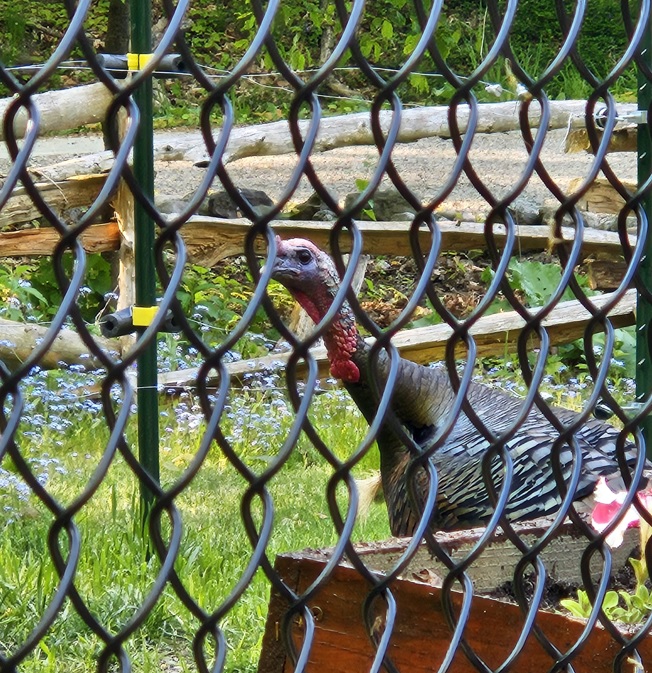Boys Night Out - By Alan Marble
07/17/2024
In case you missed it, the senior men's doubles final match last Friday was remarkable in many ways. First, four men in their 70’s played nearly 2 ½ hours of breathtaking (literally, I mean), tennis under a warm July sun. My team lost. In full disclosure, since only two teams signed up, the finals also served as quarter-finals and semi-finals. We all survived.
During my serve, the other really interesting event occurred. A hen wild turkey made her matronly way by the shuffleboard court, surrounded by her considerable flock of poults, as baby turkeys are called. It was a late brood, the poults still small and quite downy, and they did not stray far from Mom’s side. Many nesting birds will try again, and again, to pull off a nest of young if the earlier nests are destroyed by weather, or devoured by predators. Eventually, the females run out of hormones and leave the season behind. In this case, she had evidently succeeded with her second or third try, with a large brood of perhaps 10 poults. Thankfully this happened while I was supposed to serve, because, had my opponents had the service, they would have quickly recognized my chronic failure of focus when wildlife calls, and punched me in the gut with a body serve.
 Tom turkey peek a boo
Tom turkey peek a booA couple of hours later I was driving the dogs to Bellows Beach for a swim, and a smaller bunch of wild turkeys, perhaps 6, made its way across the road with the head-bobbing/velociraptor-like gait that is proof-positive that birds are just highly evolved dinosaurs. All boys, three were big toms with long beards, the others were birds born a year ago, called “jakes,” with their stubby 2-inch-long beards. The swamp quickly swallowed them up despite their gaudy plumage and striking size.
Two years ago, I was driving home from Frankfort on M22 and was just ascending the hill before Crystal Gardens when I noticed a flicker of movement in the scrubby pines on the right side of the road. I put on the brakes and came to a dead stop, much to the displeasure of the driver of the vehicle behind me. He leaned on the horn, just as a large velvet-antlered buck stepped out on the road and, without looking in my direction, walked across the highway. Honk! And a second buck stepped out and moseyed across the road. Honk! Honk! Buck number 3 followed suit, followed quickly by buck number 4. I waited another moment and then resumed my drive home, resisting the temptation to step out of the truck and tell the other driver that he need not thank me for saving him a wrecker bill and an insurance claim.
What gives? In many species of animals and birds, the sexes rarely hang-out together. If you drive Grace Road on a summer night and toss the beam of your headlights into a field full of reflective eyes, they will either be all does and this-year’s fawns, or they will all be adult bucks. Period. If you spot a conga-line of turkeys crossing the road in December and you just get your binoculars up as the last one steps out on the gravel, and it is a tom, you can be assured that all of the rest were boys, heading for a masculine night of, well, whatever tom turkeys do while roosting in trees, high above the ground in the dark.
The large cohort of deer which moves through Crystalia in summer is entirely comprised of does and this-year’s fawns. It is a sizable bunch - I’ve counted as many as 14 at a time as they high-tail it up the forested dunes, stopping halfway up to check the backtrail. If you see a large, solitary deer, check out its head to see if it is sprouting this fall’s antlers. Look closely and you will spot the beginnings of a rack.
A sow raccoon with her chittering kits will have nothing to do with a big boar raccoon, despite the possibility that he was the dad. Same holds true for black bears, even more so with grizzlies and brown bears since those males have a penchant for eating cubs if the opportunity presents itself.
There are two seasons which serve as a melting pot for the sexes. First and foremost is the breeding season. Spring for turkeys and all other birds and fall for white-tailed deer. Even then, the contact between the sexes is usually fleeting. A buck will stalk a doe to determine if she is receptive to his advances. Whether she nods her head or bolts from the scene, the buck will usually resume his bachelor status until the hormonal drive of the rut stirs him up again.
Tom turkeys like to gather a harem, spending mornings and nights with them in their roosts. By mid-morning, however, the hens have had enough of the boys' shenanigans and wander off, together, to feather their nests or enjoy a peaceful moment of gobbling grasshoppers.
The other factor that brings males and females together is the northern winter (or at least the winters we used to have). In a heavy winter, with extreme cold and deep snow, deer will gather in large homogenous groups in forests of pine, cedar and hemlocks to forage for food, stamp down the snow and feel the relief of even a few degrees warmer air under the umbrella of branches. Turkeys assemble in similar flocks and seek out agricultural fields and wooded areas with a heavy crop of fallen acorns and beech nuts to scratch down in the snow with their formidable feet and claws.
The ebb and flow of nature, honed over thousands of years, immutable and predictable…until it isn’t!
